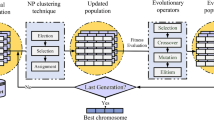Abstract
Given a set of objects characterized by a number of attributes, hidden patterns can be discovered in them for the grouping of similar objects into clusters. If each of these clusters can be considered as exemplifying a certain concept, then the problem concerned can be referred to as a concept discovery problem. This concept discovery problem can be solved to some extent by existing data clustering techniques. However, they may not be applicable when the concept involved is vague in nature or when the attributes characterizing the objects can be qualitative, quantitative, and fuzzy at the same time. To discover such concepts from objects with such characteristics, we propose a Genetic-Algorithm-based technique. By encoding a specific object grouping in a chromosome and a fitness measure to evaluate the cluster quality, the proposed technique is able to discover meaningful fuzzy clusters and assign membership degrees to objects that do not fully exemplify a certain concept. For evaluation, we tested the proposed technique with simulated and real data and the results are found to be very promising.
Similar content being viewed by others
References
Bezdek, J. C., 1981: Pattern Recognition with Fuzzy Objective Function Algorithms, Plenum Press, New York.
Carbonell, J. and Langley, P., 1987: Machine learning, in S. C. Shapiro (ed.), Encyclopedia of Artificial Intelligence, Wiley, New York, pp. 464-488.
Chan, K. C. C. and Wong, A. K. C., 1990: APACS: A system for automated pattern analysis and classification, Computational Intelligence, 6, 119-131.
Chan, K. C. C., Wong, A. K. C. and Chiu, D. K. Y., 1988: OBSERVER: A probabilistic learning system for ordered events, in J. Kittler (ed.), Pattern Recognition, Springer-Verlag, London, pp. 507-517.
Cheesman, P. and Stutz, J., 1995: Bayesian classification (AUTOCLASS): Theory and results, in U. M. Fayyad, G. P. Shapiro, P. Smythe and R. Uthurusamy, (eds.), Advances in Knowledge Discovery and Data Mining, Ch.6, AAAI/MIT Press.
Davis, L., 1991: Handbook of Genetic Algorithms, VanNostrand Reinhold, New York.
Ester, M., Kriegel, H.-P., Sander, J. and Xu, X., 1996: A density-based algorithm for discovery clusters in large spatial databases with noise, in Proc.2nd Int.Conf.on Knowledge Discovery and Data Mining (KDD-96).
Everitt, B. S., 1993: Cluster Analysis, 3rd edn., Edward Arnold, New York.
Fayyad, U., Piatetsky-Shapiro, G., Smyth, P. and Uthurusamy, R., (eds.), 1996: Advances in Knowledge Discovery and Data Mining, MIT Press.
Fisher, D. H., 1987: Knowledge acquisition via incremental conceptual clustering, Machine Learning, 2(2), 139-172.
Li, C. and Biswas, G., 1997: Unsupervised clustering with mixed numeric and nominal data-A new similarity based agglomerative system, in First Pacific-Asia Conf.on Knowledge Discovery & Data Mining, February 1997, pp. 35-48.
Michaud, P., 1997: Clustering techniques, Future Generation Computer System 13(2/3), 135-147.
Ng, R. T. and Han, J., 1994: Efficient and effective clustering methods for spatial data mining, in Proc.20th Int. Conf.on Very Large Databases, Santiago, Chile, September 1994, pp. 144-155.
Pedrycz, W., 1996: Data mining and fuzzy modeling, in 1996 Biennial Conf.of the North American Fuzzy Information Processing Society, NAFIPS 1996, 19-22 June 1996, pp. 263-267.
Syswerda, G., 1989: Uniform crossover in genetic algorithms, in Proc.3rd Int.Conf.Genetic Algorithms, San Morgan Kaufmann, Mateo, CA, p. 2.
Whitley, D. and Kauth, J., 1988: Genitor: A different genetic algorithm, in Proc.Rocky Mountain Conf.Artificial Intelligence, Denver, CO, pp. 118.
Zhang, T., Ramakrishnan, R. and Livny, M., 1996: BIRCH: An efficient data clustering method for very large databases, in Proc.ACM-SIGMOD Conference on Management of Data, Montreal, Canada.
Author information
Authors and Affiliations
Rights and permissions
About this article
Cite this article
Chung, L.L.H., Chan, K.C.C. Evolutionary Discovery of Fuzzy Concepts in Data. Brain and Mind 4, 253–268 (2003). https://doi.org/10.1023/A:1025465914366
Issue Date:
DOI: https://doi.org/10.1023/A:1025465914366




